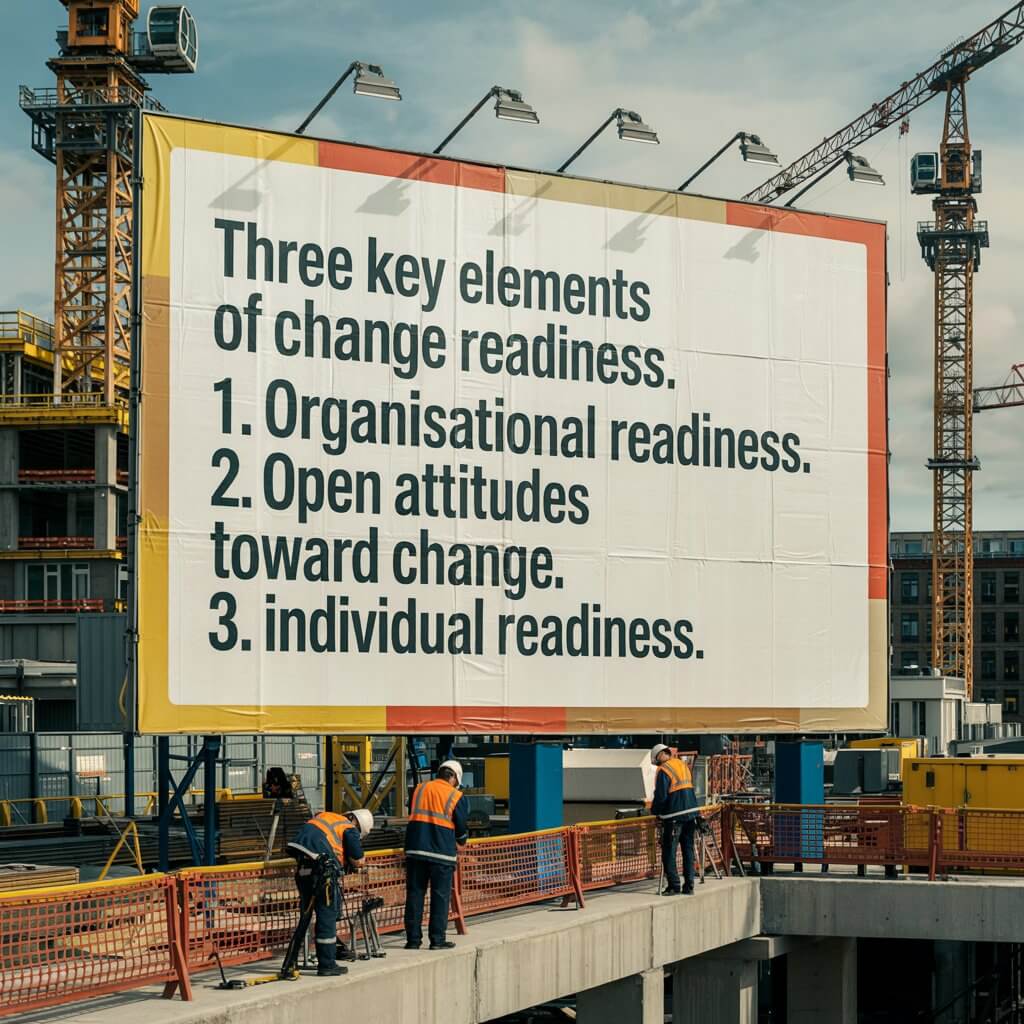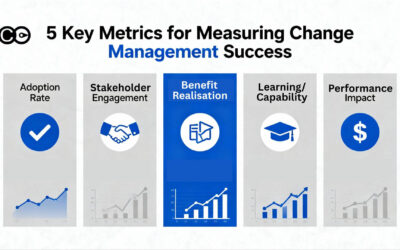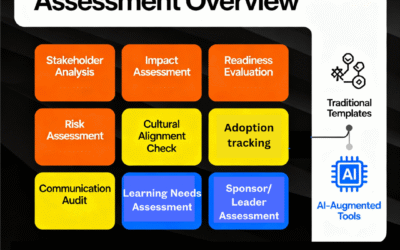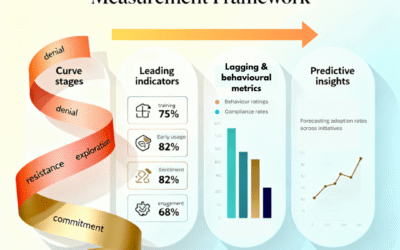The topic of change is often inundated with literature stressing that it is about people, feeling, attitudes and behaviour. While these are important, lot of articles centred about the human-nature of change often ignore the importance of data during the change and transformation process. This is no different for the topic of employee readiness for change. People’s attitudes and behaviour need to be observed, measured and tracked during change.
Employee readiness for change is a critical factor that determines the outcome of organisational transformations. By leveraging data-driven insights, companies can proactively assess and enhance their employees’ preparedness, paving the way for smoother transitions and improved business results.
Let’s explore the concept of employee readiness for change and delve into strategies for using data to optimise readiness during transformations. We will discuss key metrics, change readiness assessments, employee engagement techniques, and real-time monitoring to help organisations navigate change effectively.
What is Employee Readiness for Change?
Employee readiness for change refers to the extent to which individuals within an organisation are prepared, willing, and capable of embracing and implementing change. It encompasses their understanding of the change, their motivation to support it, and their ability to adapt and perform effectively in the new environment.
Assessing employee readiness involves evaluating three key elements:
- Organisational readiness: This aspect focuses on the company’s overall preparedness for change, including factors such as leadership commitment, resource availability, and clear objectives.
- Open attitudes toward change: Gauging employees’ understanding and willingness to embrace change is crucial. Positive attitudes contribute to successful resistance management and building change readiness.
- Individual readiness: On a personal level, assessing each employee’s readiness, willingness, and ability to adapt to change is essential. This involves considering their skills, knowledge, and emotional preparedness.
Note that individual readiness is only one component of the overall readiness. A lot of people only focus on this to the detriment of truly assessing the overall readiness.
By conducting a comprehensive assessment of these elements, organisations can gain valuable insights into their employees’ readiness for change. This information serves as a foundation for developing targeted strategies to enhance readiness and facilitate successful transformations.
How to Use Data to Improve Employee Readiness During Transformations
Harnessing the power of data analytics is essential for enhancing workforce preparedness during organisational transformations. By systematically gathering and interpreting relevant data, organisations can uncover potential obstacles and craft bespoke strategies to bolster readiness and ensure seamless transitions.
Determining Critical Metrics for Change Preparedness
To effectively utilize data, organisations must first establish the critical metrics that will serve as indicators of readiness. These metrics provide a foundation for assessing the current state and tracking future progress:
- Engagement indices: Measure the degree to which employees are actively involved and invested in organisational activities. High engagement suggests a supportive environment for change initiatives.
- Flexibility indicators: Evaluate employees’ capacity to adjust to new roles and technologies. This metric identifies those who may benefit from targeted support.
- Completion rates of developmental programs: Monitor the percentage of the workforce completing essential training. This figure highlights areas where skill enhancement is necessary.
Executing a Holistic Change Preparedness Evaluation
With metrics in place, conduct a thorough evaluation of change preparedness at both organisational and individual levels. Utilize surveys, interviews, and focus groups to gather rich data. This comprehensive approach reveals resistance points and directs attention to intervention opportunities:
- Cultural assessment: Analyse underlying cultural traits that influence how change is perceived and implemented. Insights into assertiveness and hierarchy can guide communication strategies.
- Leadership analysis: Assess the readiness and skillset of leaders to champion change. Effective leadership is pivotal for the success of transformation efforts.
Enhancing Workforce Involvement Through Data Insights
Data-driven insights can significantly enhance employee involvement during periods of change. By examining workforce data, organisations can tailor communication and training to better resonate with their employees:
- Customized messaging: Develop communication that speaks directly to the needs and concerns of various employee segments. This ensures messages are impactful and engaging.
- Focused learning initiatives: Identify specific knowledge gaps and create targeted training programs. Customized learning enhances employees’ ability to adapt to change confidently.
Continuous Strategy Adaptation via Real-Time Data
Ongoing monitoring of strategy effectiveness through real-time analytics is vital. This continuous process allows organisations to refine their approaches based on evolving data patterns, maintaining high levels of readiness:
- Regular data collection: Actively seek feedback from employees regarding their transition experiences. This input is crucial for identifying areas needing adjustment.
- Dynamic decision-making: Leverage real-time (or least recent) data to inform strategic decisions and optimize change management initiatives, ensuring they remain aligned with organisational goals.
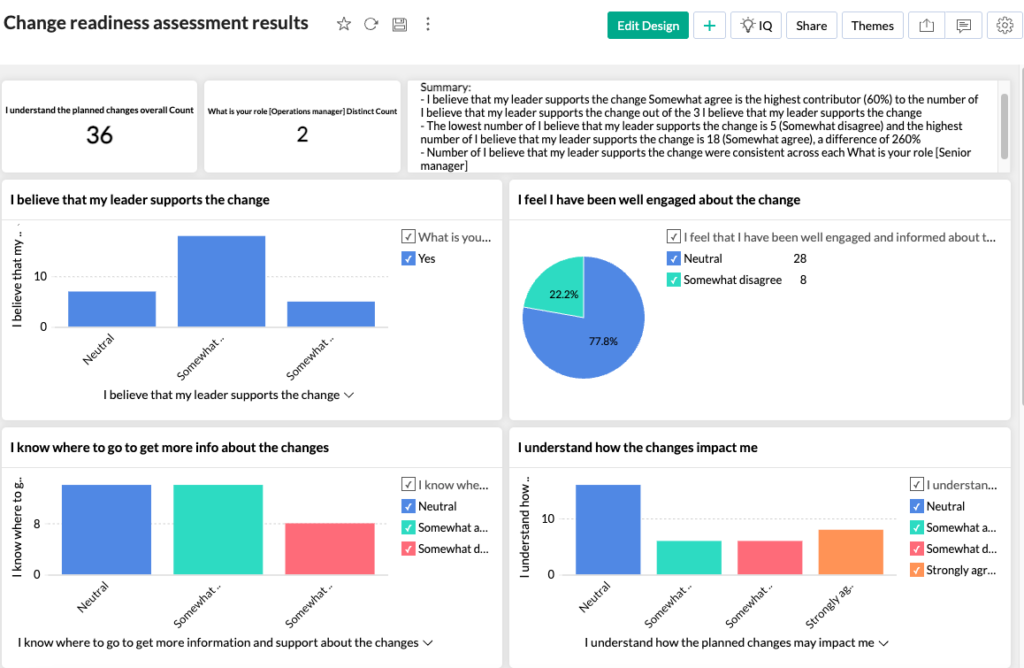
1. Identify Key Metrics for Change Readiness
Establishing a robust framework of metrics is fundamental to accurately gauge change readiness within an organisation. These metrics function as critical indicators, allowing leaders to monitor the pulse of their workforce during transformation initiatives. A well-defined set of metrics provides a structured approach to assessing readiness and identifying areas requiring attention.
Engagement Indicators
Evaluating employee engagement is crucial for understanding the workforce’s readiness for change. This involves gathering insights into how employees perceive their roles and the organisation’s objectives. A workforce that demonstrates high levels of commitment and enthusiasm tends to be more agile and supportive of change efforts. Methods such as employee sentiment analysis and engagement surveys can help capture these dynamics, offering a nuanced view of organisational health.
Flexibility Metrics
Flexibility metrics provide a window into the ease with which employees can transition to new processes and systems. This involves examining historical data on change adaptability and using tools like behavioural assessments to gauge employees’ readiness for new challenges. Understanding the flexibility of employees can guide targeted support and interventions, ensuring smoother transitions during organisational shifts.
Completion Rates of Educational Programs
Monitoring the completion rates of educational initiatives is essential to assess how prepared employees are for impending changes. This metric reflects the organisation’s dedication to equipping its workforce with the skills needed for transformation. Analysing completion data, alongside post-training assessments, can offer insights into the effectiveness of learning interventions and highlight areas for development.
Together, these metrics form a comprehensive picture of an organisation’s change readiness. By establishing a baseline for these indicators, organisations can track progress over time, adjusting strategies as necessary to enhance readiness and facilitate successful transformations.
2. Conduct a Comprehensive Change Readiness Assessment
To pave the way for a successful transformation, conducting a comprehensive change readiness assessment becomes imperative. This systematic evaluation delves into the organisation’s preparedness at both the macro and micro levels, providing insights that are critical for shaping effective change strategies. Utilizing a blend of qualitative and quantitative methods, the assessment illuminates the landscape of readiness, offering a strategic foundation for decision-making.
Strategic Evaluation Components
A multifaceted readiness assessment encompasses several strategic components, each designed to gather a holistic understanding of the organisational climate:
- Cultural Insight Analysis: Delve into the organisational culture to uncover factors that may affect acceptance of change. This involves exploring existing communication styles, shared values, and prevalent behaviours that could influence the transformation journey. Gaining a clear picture of these cultural dynamics aids in crafting initiatives that resonate with the workforce’s inherent beliefs.
- Leadership Capacity Evaluation: Determine the readiness and effectiveness of leadership in spearheading change efforts. Examine their ability to inspire and motivate, as well as their capacity to navigate the complexities of organisational transformation. Strong leadership commitment is essential for instilling confidence and guiding the organisation through change.
- Resource Readiness Check: Evaluate the sufficiency and distribution of resources critical for supporting change initiatives. Consider the existing technological capabilities, financial support, and human resources available to drive the transformation. Addressing resource gaps early ensures that the organisation is well-prepared to meet the demands of change.

Analysing Data for Targeted Interventions
Upon gathering data through the readiness assessment, a thorough analysis is essential to uncover insights that inform strategic interventions. This analysis should focus on identifying potential resistance points and areas ripe for development:
- Resistance Identification: Detect and chart areas where reluctance to change may manifest. Utilize employee feedback, trends from past projects, and current mood assessments to pinpoint these zones. Understanding these resistance factors allows for proactive measures to encourage acceptance and reduce pushback.
- Opportunity Leveraging: Spot areas with high readiness levels that can be used to propel change efforts forward. Recognize organisational strengths and existing competencies that can be harnessed to support the transition. By leveraging these opportunities, organisations can accelerate progress and cultivate a culture of continuous growth.
Conducting a comprehensive change readiness assessment provides a strategic lens through which organisations can navigate the complexities of transformation. By systematically evaluating readiness and leveraging data-driven insights, organisations can craft tailored strategies that enhance employee preparedness and drive successful change outcomes.
3. Utilise Data Analytics to Foster Employee Engagement
Employing data analytics is essential to deepening employee involvement during change processes. By utilizing advanced analytical tools, organisations can uncover key drivers of motivation and engagement within their workforce. This enables the development of strategies that are not only data-informed but also tailored to enhance a culture of commitment and adaptability.
Strategic Communication Approaches
Data analytics offer organisations the ability to refine communication strategies in a way that aligns with the diverse preferences and needs of employees. By examining patterns in communication effectiveness and gathering feedback, companies can create messaging frameworks that are clear and meaningful. This strategic approach ensures that communication is not just disseminated but absorbed, fostering a sense of inclusion and understanding across the organisation.
Customised Development Pathways
Insights from analytics enable the design of development pathways that cater to the specific learning and growth needs of employees. Analysing performance metrics and capability assessments allows organisations to pinpoint where support is most needed, leading to bespoke development initiatives. These pathways not only address skill gaps but also promote a learning culture that equips employees for future challenges.
Ongoing Engagement Assessment
Real-time analytics provide a robust mechanism for continuously assessing employee engagement throughout the transformation journey. Establishing metrics that reflect engagement sentiment and participation levels helps organisations react swiftly to shifts in morale. This proactive engagement assessment ensures that initiatives remain aligned with employee expectations and organisational objectives, fostering a sustained commitment to change.
4. Monitor and Adapt Strategies Using Real-Time Data
Leveraging real-time data analytics is crucial for dynamically guiding change initiatives. This approach enables organisations to continuously evaluate the effectiveness of their strategies, ensuring they remain aligned with shifting business needs and employee expectations. By integrating adaptive feedback mechanisms, companies can refine their tactics, promoting an environment of agility and responsiveness.
Dynamic Data Acquisition
Establishing a robust system for dynamic data acquisition is essential to maintain an accurate understanding of organisational and employee dynamics. Real-time analytics platforms and dashboards provide comprehensive insights into change progress, such as engagement indices, performance metrics, and sentiment analysis. Regularly capturing this data allows organisations to proactively identify patterns and shifts that may influence the success of change initiatives.
Strategic Insights-Driven Adjustments
The insights obtained from real-time data empower organisations to make calculated adjustments to their strategies. This adaptive approach ensures that interventions remain pertinent and effective, addressing emerging challenges and capitalizing on new opportunities:
- Incorporating Employee Perspectives: Integrate direct insights from employees into strategic refinements. Understanding their experiences and perceptions offers a nuanced perspective of the change process, allowing for precise enhancements.
- Pattern Recognition: Use data patterns to recognize trends that may require strategic shifts. For example, a downward trend in engagement metrics could indicate the need for improved communication or support mechanisms.
- Efficient Resource Deployment: Employ data insights to enhance resource deployment, ensuring that efforts are concentrated where they are most impactful. This targeted approach enhances the effectiveness of change initiatives and maximizes results.
Proactive Decision-Making
Real-time data analytics enable proactive decision-making, empowering leaders to swiftly adjust to evolving conditions. This capability is vital for sustaining momentum and ensuring that change efforts remain aligned with organisational objectives. By adopting a data-informed mindset, organisations can navigate the complexities of transformation with confidence and precision.
By harnessing the power of data analytics, organisations can proactively assess and enhance employee readiness during transformations, paving the way for smoother transitions and improved business outcomes. Embracing a data-driven approach to change management is no longer optional; it is a strategic imperative for organisations seeking to thrive in an ever-evolving landscape. If you’re ready to transform your change management processes and unlock the full potential of your workforce, chat to us to explore how we can help you leverage data and insights to navigate change with confidence and precision.
To read more about change management measurement, check out our other articles here.
